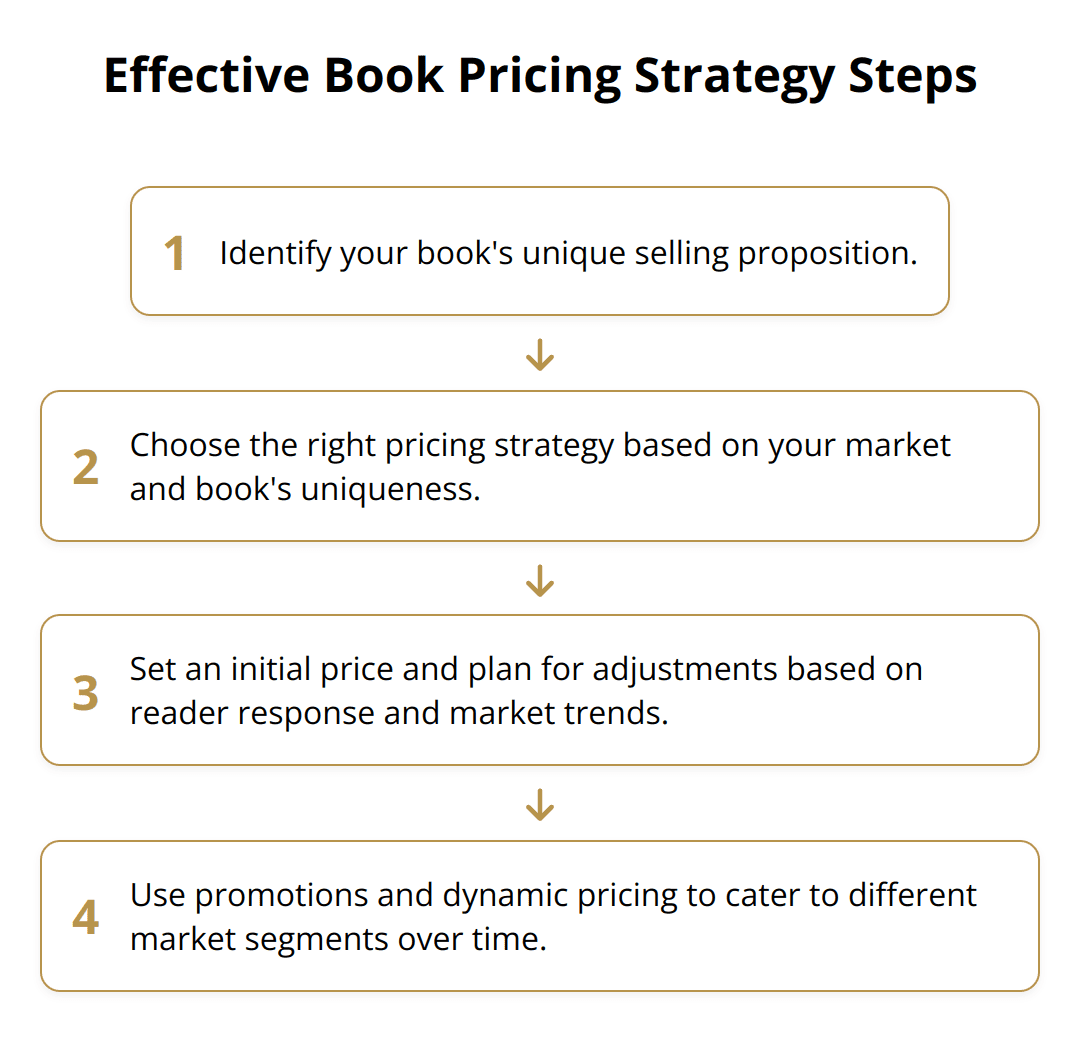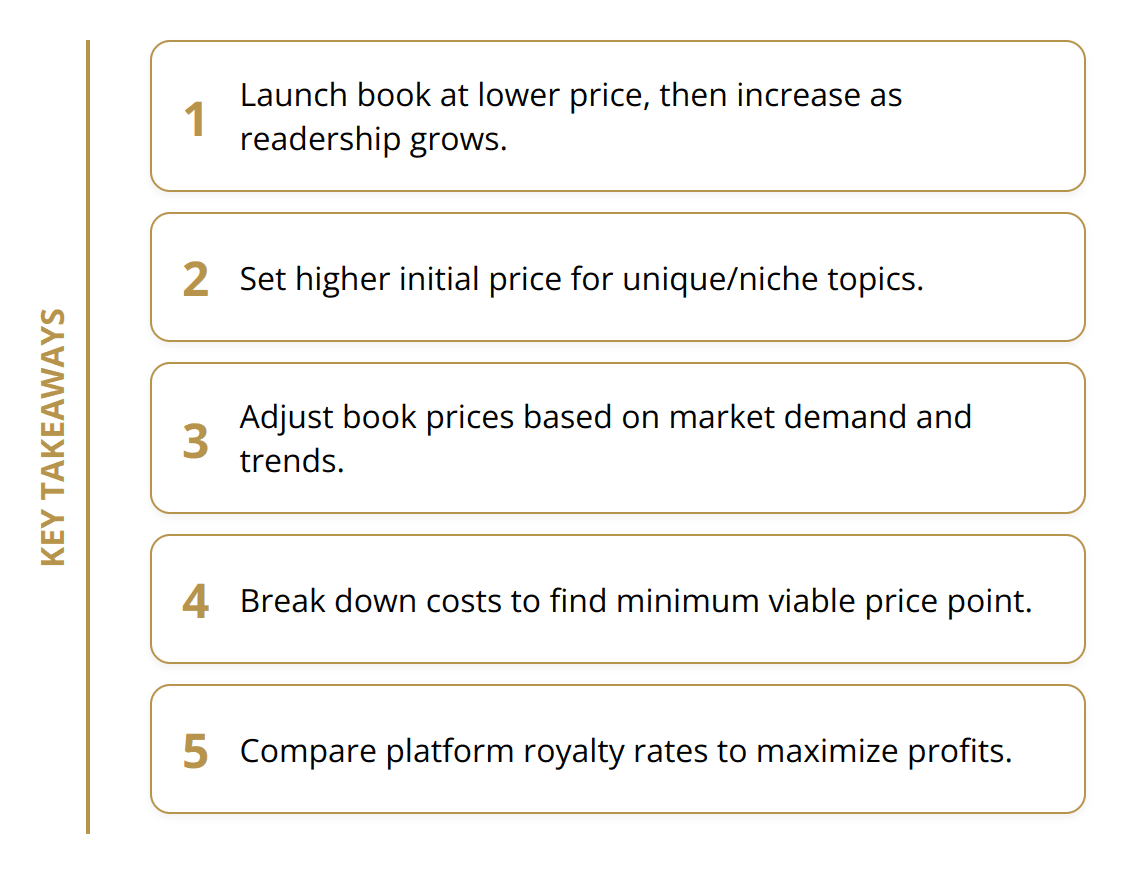Setting the right price for your book is more of an art than a science, blending market understanding with strategic finesse. At Beverly Hills Publishing, we’ve navigated these waters successfully countless times, guiding authors to make informed pricing decisions.
Our insights into the book market’s dynamics are designed to equip you with the knowledge to price your book competitively. Let’s explore how to balance costs, value, and market demand to find the sweet spot for your book’s price.
Understanding Your Market
Knowing your market inside and out is the foundation for setting the right price for your book. This step involves three critical actions: pinpointing your target audience, scrutinizing your competitors’ pricing strategies, and gauging the demand for your genre or topic.
Firstly, identifying your target audience cannot be overstated. A well-defined audience allows for tailored marketing strategies and, by extension, more effective pricing models. It’s all about understanding who is most likely to purchase your book and what is the maximum they are willing to pay for it. This involves researching demographics, interests, and purchasing habits. The goal is to have a clear picture of your ideal reader to guide your pricing strategy.

Next, analyzing competitor pricing strategies offers valuable insights. Look at books similar to yours in genre, topics, and target audience. Note their pricing range, and observe any pricing patterns or strategies that seem to work well. This does not mean you should copy your competitors’ prices directly. Instead, use this information to understand where your book fits in the market landscape.
Assessing the demand for your genre or topic is equally critical. Some genres have larger, more willing-to-pay audiences than others. For instance, specialized non-fiction topics might command higher prices due to their targeted appeal. Conversely, highly saturated markets, like romance novels, might require more competitive pricing strategies to stand out.
Here are a few practical steps you can take:
- Use tools like Amazon’s Best Sellers to research best-selling books in your genre.
- Conduct surveys or use social media to directly ask your potential readers what they are willing to pay.
- Look into industry reports or websites like Publisher’s Weekly for broader market trends.

By meticulously understanding your market, you are better positioned to set a price that not only appeals to your target audience but also ensures your book’s competitive edge in a crowded marketplace. Remember, the goal is not just to sell your book, but to do so in a way that maximizes your revenue potential while maintaining a strong connection with your readers.
Determining Book Prices
Once you’ve got a firm grasp on your market, the next logical step is to consider the various factors that directly impact your book’s pricing. This means taking a deep dive into production costs, channel distribution costs, and understanding the balance between author royalties and publishing expenses. It’s essential to strike the right balance between covering your costs and offering value to your readers.
Production Costs: The Starting Point
The initial costs of bringing a book to market can vary widely. These include expenses for editing, cover design, formatting, and, for physical books, printing. High-quality editing and design are non-negotiables—they significantly affect your book’s perceived value and marketability. Outsourcing these tasks to professionals can be costly but investing in these areas pays off by making your book more appealing to potential readers. For a rough estimate, editing and cover design can range from a few hundred to several thousand dollars depending on the complexity of your work and the professionals’ experience level.
Channel Distribution Costs: Navigating the Platforms
Where you choose to sell your book also affects pricing. Selling through large distributors like Amazon or Barnes & Noble involves different costs and revenue sharing models compared to direct sales or smaller platforms. For instance, Amazon’s KDP offers up to 70% royalties for ebooks priced between $2.99 and $9.99. Below or above this range, the royalty rate drops to 35%. Understanding the specifics of these platforms helps in setting a price that ensures a fair return while being competitive.
Balancing Author Royalties and Publishing Expenses
Authors must navigate the fine line between ensuring they receive fair compensation for their work and keeping overall costs manageable to maintain competitive pricing. Royalties, the author’s cut of the book sales, are a significant factor to consider. For self-published authors, higher royalties per sale might mean you can afford to sell fewer books at a higher price point. However, traditionally published authors often have less control over pricing but benefit from the publisher’s marketing and distribution networks.
Here are some actionable steps you can take:
- Break down your production and distribution costs to understand your minimum viable price.
- Compare royalty rates across different platforms to find the best deal.
- Consider the benefits of different publishing routes—self-publishing offers more control over pricing, but traditional publishing can reduce upfront costs.
- Experiment with pricing within the acceptable ranges of major selling platforms to find your book’s sweet spot.

By carefully considering these factors, authors can set a book price that maximizes profits while attracting and retaining readers. It’s a delicate balance, but with the right approach, it’s entirely achievable.
Effective Book Pricing Strategies
When it comes to pricing your book, a one-size-fits-all approach simply doesn’t cut it. Depending on where you are in your author journey, the uniqueness of your content, and the flexibility you have over time, different strategies can be applied to maximize your revenue and reach. Let’s dive into effective strategies personalized to these contexts.
Start Strong with Penetration Pricing
If you’re a new author aiming to make a splash in a crowded market, penetration pricing is a powerful strategy. The key here is to set your book price lower than the competition to quickly attract readers. This low pricing strategy can boost your book’s visibility and reader base, which is essential for new authors struggling to get noticed. Once you’ve established a solid reader foundation, you can gradually increase your price.
Actionable steps:
- Launch your book at a lower price point than similar titles.
- Use the initial low price to gather reader reviews and build buzz.
- Gradually increase your price as your readership grows.
Penetration pricing is not about undervaluing your work but rather an investment in building your author brand and loyal readership.
Leverage Unique Content with Price Skimming
For books covering unique or niche topics where you are among the few experts, price skimming can be particularly effective. This involves setting a higher initial price to maximize returns from readers who have been eagerly awaiting your content or those who find unique value in your specific expertise. As the initial demand is satisfied and more competitors possibly enter the market, you can then lower the price to appeal to a more price-sensitive audience.
Actionable steps:
- Set a premium price if your book covers a unique or under-explored topic.
- Monitor sales and feedback closely, ready to adjust as the market evolves.
- Implement a scheduled price reduction plan to widen your audience over time.
This approach rewards early adopters while eventually making your book accessible to a broader audience.
Maximize Returns with Dynamic Pricing
Dynamic pricing is a flexible strategy that adjusts your book price in response to various market factors, such as demand, competition, and promotional activities. This strategy requires vigilance and a willingness to respond to market trends but can significantly boost your revenue over time. By adjusting prices in real-time, you cater to both ends of the market: launching promotions to attract more readers during low-demand periods and capitalizing on high demand when it presents itself.
Actionable steps:
- Use analytics tools to monitor market demand and adjust prices accordingly.
- Schedule regular reviews of your pricing strategy to ensure it aligns with current market trends.
- Plan promotions around key holidays or events when book sales typically spike.

For authors willing to stay engaged with market trends and data, dynamic pricing offers a way to continually optimize their earnings.
By understanding and applying these pricing strategies, authors can better position their books in the market, attract and retain readers, and maximize their revenue potential. Each strategy has its merits, and choosing the right one depends on your current situation, goals, and the unique value your book offers.
Final Thoughts
Determining the best pricing strategy for your book is an ongoing process that requires a keen understanding of the market, flexibility, and a commitment to continuous learning. As we’ve outlined, being well-informed about your target audience, competitive landscape, and the intrinsic value of your book is fundamental. Yet, beyond these initial steps lies the continuous task of adapting to market changes and reader preferences.

Flexibility and market awareness are paramount. The book market is dynamic, with trends shifting and new competitors emerging regularly. An author’s ability to adapt their pricing strategy in response to these changes can make the difference between mediocre sales and outstanding success. This might mean adjusting your book’s price in response to a sudden surge in demand, a change in competitors’ strategies, or feedback from your readers.
Continuous learning and adjusting your strategies are also key. The book industry evolves, and so should your approach to pricing your book. Stay informed about broader market trends, reader behavior, and innovative pricing strategies. Monitoring your sales data and reader feedback will provide valuable insights that can guide your pricing decisions.
At Beverly Hills Publishing, we’re committed to helping authors succeed by combining quality publishing with strategic branding and marketing. Our integrated approach is designed to propel authors beyond traditional publishing, establishing them as leading authorities in their fields. We understand that determining the right book pricing is an integral part of this process. To this end, we offer comprehensive support and guidance to ensure our authors can price their books effectively, enhancing their brand and maximizing their revenue potential.
In summary, setting the right price for your book is not a one-time decision but a strategic element of your overall author brand. By understanding your market, staying flexible, and continuously adjusting your strategies based on data and feedback, you can ensure your book reaches its full potential. Remember, your goal is not just to sell books, but to build a lasting connection with your readers and establish yourself as a leader in your industry.















































































































































































































































